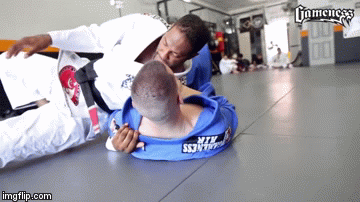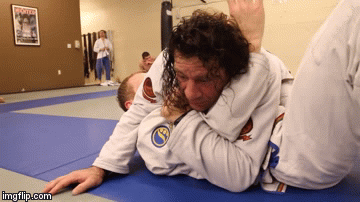
The side control position is a position of different opportunities at different times of training BJJ. For the white belt grappler, it is mostly the safe heaven position from the top. Passing the guard to get to side control is as good as getting any submission. At blue belt, it is mostly about staying there for long enough to get to the mount or back. Submissions from side control really enter the frame at around the purple belt level. At brown belt, it is all about weight distribution and effectiveness without too much effort. After that, at the black belt, side control is just another position where battles for details decide the outcome.
What I stated above is just a general idea of what happens from a certain Jiu-Jitsu position as people progress through the art. There are no rules, and white belts might turn out to have a deadly submission game from there too. That said, today’s focus is on the “purple belt phase”, i.e. submissions from side control. The side control position is the pinnacle of the phrase “position before submission”. Retaining side control is no easy feat even for seasoned grapplers. Conversely, attacking while keeping the position really requires experience and the appropriate choice of techniques. Just like with every other position, some submission options are simply more reliable than others.
The reason why attacking from side control is so varied is due to the nature of the position. The term side control refers to a few very different-looking positions. For example, both the regular side control position and the North-South are side control variations, despite being positionally very different. Normally, submissions from side control vary depending on the position. Even then, it is important to understand how to stay in position while setting u a submission attempt. Otherwise, flying over your opponent is a very viable version of how events end.
The “Side Control Destruction Gi & No-Gi” DVD by Will Grundhauser is a very comprehensive guide to submitting people from all side control variations. It is full of crucial details that make you feel like a ton of bricks while you’re hunting for the subs!
How To Attack From Side Control
The one thing you need to understand about side control is that it is very dual in nature. You can either be static and have utter and complete control, or be dynamic and go for submissions. Hunting for submissions from side control means you need to understand how to distribute your weight and prevent the opponent from escaping. Static control, on the contrary, is mostly something competitors use to secure points.
On the subject of points, let’s clear up a common misunderstanding. You do not get any points for getting side control. The reason most people associate the position by getting three points is because of passing. When you pass the guard, you end up in side control in most cases. The three points you get are for the pass, not the position itself. Another common reason for the confusion is ‘sweeping”. If you find yourself on the bottom of side control, and you flip positions, you won’t get any points. Sweeps work from guard positions only so the only thing you get is a reversal, which might bring you an advantage.
Technically speaking, there era two major factors in attacking from side control. Both affect your attacking options very much, defining what you can and cannot do. These are the ways in which you position your arms and your legs. Namely, you can’t go for a leg lock directly from North-South, without completely losing control over the opponent. You need to understand how limb positioning affects your attacking opportunities from side control in order to be effective from the position.
Nasty Submissions From Side Control
Submissions from side control that work with a high percentage are not that many. While there are plenty of attacking options, not all of them are easy to pull off. Especially when you factor in weight distribution and all the technical details. In that sense, the submissions we’re about to go over, are both easy to get and can be set up without your opponent even noticing.
In terms of availability, the submissions from side control you can get are chokes, arm locks, and leg locks. Learning how to use them is not hard when you know which submission fits which positional variation. Furthermore, backing up every submission with a transition to mount, back or Ashi Garami is also key. Finally, all these submissions work as a chain as well, offering you the option to be a constant submission threat from side control.
Attacking The Arms


Gi And No-Gi Chokes


Leg Lock Submissions From Side Control


DVD and DIGITAL Instructionals Related to Submissions From Side Control :
- ROMULO BARRAL’S SIDE CONTROL SECRETS
- MARCELLO MONTEIRO SIDE CONTROL ATTACKS
-
Side Control Attacks & Submissions: Old School Evolution by Fabio Gurgel
How To Torture Everyone With Crushing Knee On Belly Pressure


![Darce Choke Encyclopedia – Origins, Mechanics and Variations [2025] BJJ, choke, Brabo, BJJ Darce Choke, D'arce Choke, Darce BJJ Choke](https://bjj-world.com/wp-content/uploads/2017/11/JungPoirierLeeYahoo-218x150.jpg)










![Leg Locks Finishes Helena Crevar DVD Review [2025] Leg Locks Finishes Helena Crevar DVD Review](https://bjj-world.com/wp-content/uploads/2025/04/leg-locks-finishes-helena-crevar-dvd-review-218x150.png)


![Leg Entanglement System: X Lock Owen Jones DVD Review [2025] Leg Entanglement System: X Lock Owen Jones DVD Review](https://bjj-world.com/wp-content/uploads/2025/04/leg-entanglement-system-x-lock-owen-jones-dvd-review-218x150.png)
![[WATCH] John Wick Invitational 2 Delivers Viral Suit-Jitsu Spectacle [WATCH] John Wick Invitational 2 Delivers Viral Suit-Jitsu Spectacle](https://bjj-world.com/wp-content/uploads/2025/04/john-wick-invitational-2-suit-jitsu-spectacle-218x150.png)
![Leg Entanglement System: X Lock Owen Jones DVD Review [2025] Leg Entanglement System: X Lock Owen Jones DVD Review](https://bjj-world.com/wp-content/uploads/2025/04/leg-entanglement-system-x-lock-owen-jones-dvd-review-324x235.png)
![Advantage Over Time Outside Passing Jozef Chen DVD Review [2025] Advantage Over Time Outside Passing Jozef Chen DVD Review](https://bjj-world.com/wp-content/uploads/2025/03/outside-passing-jozef-chen-dvd-review-100x70.png)

![Ginastica Natural Alvaro Romano DVD Review [2024] Ginastica Natural Alvaro Romano DVD Review](https://bjj-world.com/wp-content/uploads/2024/12/ginastica-natural-alvaro-romano-dvd-review-100x70.png)


![Gracie Secrets Closed Guard Kyra Gracie DVD Review [2024] Gracie Secrets Closed Guard Kyra Gracie DVD Review](https://bjj-world.com/wp-content/uploads/2024/12/closed-guard-kyra-gracie-dvd-review-100x70.png)


![No-Gi Open Guard K-Guard Lachlan Giles DVD Review [2024] No-Gi Open Guard K-Guard Lachlan Giles DVD Review](https://bjj-world.com/wp-content/uploads/2024/12/no-gi-open-guard-k-guard-lachlan-giles-dvd-review-100x70.png)



![Higher Tripod Passing Craig Jones DVD Review [2025] Higher Tripod Passing Craig Jones DVD Review](https://bjj-world.com/wp-content/uploads/2025/02/higher-tripod-passing-craig-jones-dvd-review-100x70.png)
![Basic Closed Guard Jasmine Rocha DVD Review [2024] Basic Closed Guard Jasmine Rocha DVD Review](https://bjj-world.com/wp-content/uploads/2024/11/basic-closed-guard-jasmine-rocha-dvd-review-100x70.png)
![How To Knee Cut Junny Ocasio BJJ DVD Review [2025] How To Knee Cut Junny Ocasio BJJ DVD Review](https://bjj-world.com/wp-content/uploads/2025/02/how-to-knee-cut-junny-ocasio-bjj-dvd-review-100x70.png)
![Modernized Headquarters Passing Shawn Melanson DVD Review [2025] Modernized Headquarters Passing Shawn Melanson DVD Review](https://bjj-world.com/wp-content/uploads/2025/04/headquarters-passing-shawn-melanson-dvd-review-100x70.png)
![Old School BJJ Ricardo Cavalcanti Fundamentals DVD Review [2024] Old School BJJ Ricardo Cavalcanti Fundamentals DVD Review](https://bjj-world.com/wp-content/uploads/2024/09/old-school-bjj-ricardo-cavalcanti-dvd-preview-100x70.png)

![Creating Back Exposure Luke Griffith DVD Review [2025] Creating Back Exposure Luke Griffith DVD Review](https://bjj-world.com/wp-content/uploads/2025/01/creating-back-exposure-luke-griffith-dvd-review-100x70.png)


![Crush The Guard Vagner Rocha DVD Review [2024] Crush The Guard Vagner Rocha DVD Review](https://bjj-world.com/wp-content/uploads/2024/10/crush-the-guard-vagner-rocha-dvd-review-100x70.png)
![Closet Closed Guard Craig Jones DVD Review [2025] Closet Closed Guard Craig Jones DVD Review](https://bjj-world.com/wp-content/uploads/2025/03/closet-closed-guard-craig-jones-dvd-review-100x70.png)

![I Got Your Back Jake Straus DVD Review [2025] I Got Your Back Jake Straus DVD Review](https://bjj-world.com/wp-content/uploads/2025/03/i-got-your-back-jake-straus-dvd-review-100x70.png)
![Foot Sweep the World Dainis Nguyen-Huu DVD Review [2024] Foot Sweep the World Dainis Nguyen-Huu DVD Review](https://bjj-world.com/wp-content/uploads/2024/11/foot-sweep-the-world-dainis-nguyen-huu-dvd-review-100x70.png)
![Position And Submission Escapes Craig Funk DVD Review [2025] Position And Submission Escapes Craig Funk DVD Review](https://bjj-world.com/wp-content/uploads/2025/02/position-and-submission-escapes-craig-funk-dvd-review-100x70.png)
![How to Double Leg Anyone Kevin Lee DVD Review [2024] How to Double Leg Anyone Kevin Lee DVD Review](https://bjj-world.com/wp-content/uploads/2024/11/how-to-double-leg-anyone-kevin-lee-dvd-review-100x70.png)
